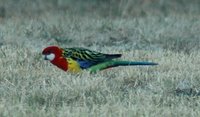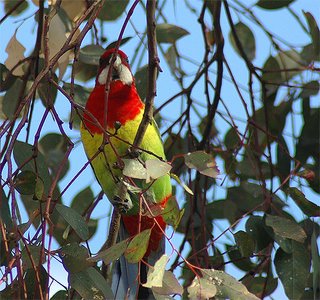 Around the Canberra Hospital, in Garran, A.C.T. is a large area of short-mown grassland. This land passes for a park, in Canberra. Much of it is roadside verge, but a large area is primary school grounds, too. I aroused some consternation last week, when taking photographs of the ground-feeding birds, behind the school, after hours. I suddenly realised that the managers of a local child-care centre were apprehensive about "a man" in a car, with a camera, (seemingly) taking photos (presumably - to their point of view) of their precious charges. Innocent, Your Honour - it was the "birdie" in the grass which I was photographing. Anyway, I will cease "prowling" their yard, during their business hours, in future. Such an innocent pass-time, so easily misunderstood, in this suspicious age.
Around the Canberra Hospital, in Garran, A.C.T. is a large area of short-mown grassland. This land passes for a park, in Canberra. Much of it is roadside verge, but a large area is primary school grounds, too. I aroused some consternation last week, when taking photographs of the ground-feeding birds, behind the school, after hours. I suddenly realised that the managers of a local child-care centre were apprehensive about "a man" in a car, with a camera, (seemingly) taking photos (presumably - to their point of view) of their precious charges. Innocent, Your Honour - it was the "birdie" in the grass which I was photographing. Anyway, I will cease "prowling" their yard, during their business hours, in future. Such an innocent pass-time, so easily misunderstood, in this suspicious age. Give me the tranquil innocence of Robertson's Hampden Park, any day.
*****
The photo above is of a slightly camera-shy adult male Eastern Rosella, Platycercus eximius in stunningly beautiful plumage.
*****
 Here is a slightly "desperate" shot of an Eastern Rosella, (up in a Gum tree) which I have published, to contrast with another slightly more "artistic" shot of a Crimson Rosella (below).
Here is a slightly "desperate" shot of an Eastern Rosella, (up in a Gum tree) which I have published, to contrast with another slightly more "artistic" shot of a Crimson Rosella (below). The E. R. (a male - with a clearly marked red head, is the iconic parrot of commerce in Australia, thanks to "Rosella" brand products, notably Tomato Sauce. This little web site, proudly boasts that an Australian company has rescued the brand name, from foreign hands, after more than 50 years. Well done them!)
Here is a link to an illustration which clearly shows the 2 main species of Rosellas in Eastern Australia (unfortunately, without mentioning the red bird, at all - it is a Kiddies site).
 The taxonomists have simplified a range of these Rosella into these two super-species, based upon whether they have white cheeks (Eastern Rosella), or blue cheeks (Crimson Rosella) (Platycercus elegans) . The reason is that there is an enormous colour gradient amongst these birds, which early ornithologists had conveniently separated into "good species", because of their geographical spread. In fact, CSIRO has demonstrated that the gradient of forms is virtually continuous, with overlapping characteristics (in both species groups) to be found along their parallel ranges. While the Eastern Rosella group mature to a fixed colour in a single season, the Crimson Rosellas start with a green and blue juvenile plumage, and slowly develop the brilliant dark red colouration, after some time - which time might vary with the locality.
The taxonomists have simplified a range of these Rosella into these two super-species, based upon whether they have white cheeks (Eastern Rosella), or blue cheeks (Crimson Rosella) (Platycercus elegans) . The reason is that there is an enormous colour gradient amongst these birds, which early ornithologists had conveniently separated into "good species", because of their geographical spread. In fact, CSIRO has demonstrated that the gradient of forms is virtually continuous, with overlapping characteristics (in both species groups) to be found along their parallel ranges. While the Eastern Rosella group mature to a fixed colour in a single season, the Crimson Rosellas start with a green and blue juvenile plumage, and slowly develop the brilliant dark red colouration, after some time - which time might vary with the locality. Tasmania's "Green Rosella", and the Murray River region's "Yellow Rosella" never make the transition to a red bird. I believe that they might still be "lumped" within the Crimson Rosella species, yet. (not absolutely sure, folks. But certainly, they are within the super-species group. The reason? The Green Rosella and the Yellow Rosella have the same pattern of blue cheek patches as the Crimson Rosella.
 So, no matter the main body colour of the bird, think, blue cheek patches (Crimson Rosella group) or white cheek patches (Eastern Rosella group).
So, no matter the main body colour of the bird, think, blue cheek patches (Crimson Rosella group) or white cheek patches (Eastern Rosella group). Here is a link to the strongly divergent Pale-headed Rosella of Queensland and northern NSW, with a yellow, not red head, but, white cheek patches (although, disturbingly, blue underneath the cheek). It is within the Eastern Rosella (white cheek patches) group. Life is never simple!
For the record, in Robertson, green birds with blue cheek patches are commonly seen. They are immature birds, probably in their first year of life. These changes are recorded beautifully in the Gould illustrations published atthe link above. At all stages of maturity of this species, their wings are blue-marked, and their tails are always tw0-toned blue. The tail feathers are popular as ornamentation in the "Bowers" of Satin Bower Birds, in Robertson.
A Google "Image" search reveals a group of varied birds which will easily enough illustrate this discussion for you. Here is a link to a messy-looking changeling bird: a half red, and half-green, Crimson Rosella (nice photo, scruffy bird). Such birds are commonly seen in Robertson. In general, the Crimson Rosella is a bird fond of heavy cover, and wet districts (i.e., Robertson, in general). It is the commonest Rosella of Robertson (found nearly everywhere about the village). They love Blackwood Wattles, and Sassafras, as well as adjacent grasslands, but they happily live in the rainforest.
The Eastern Rosella loves grasslands and, in particular, large Eucalypt trees. So, in Robertson, it will be found occasionally near Hampden Park, but certainly at the Show Grounds. It becomes increasingly more common towards Moss Vale and Bowral - not for reasons of snobbery - but because that country is more open, more farmed, and has more natural gum trees.

No comments:
Post a Comment